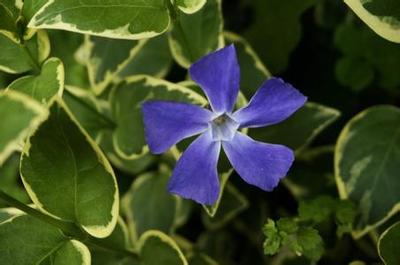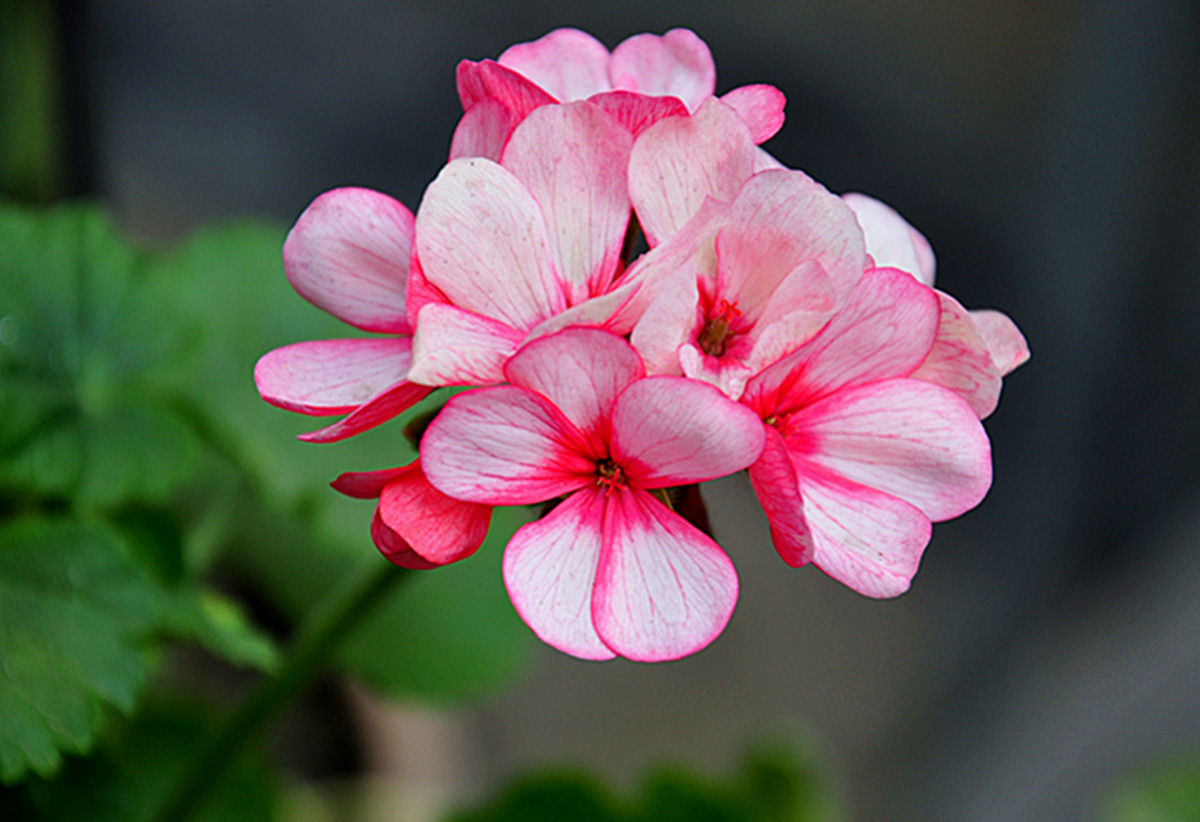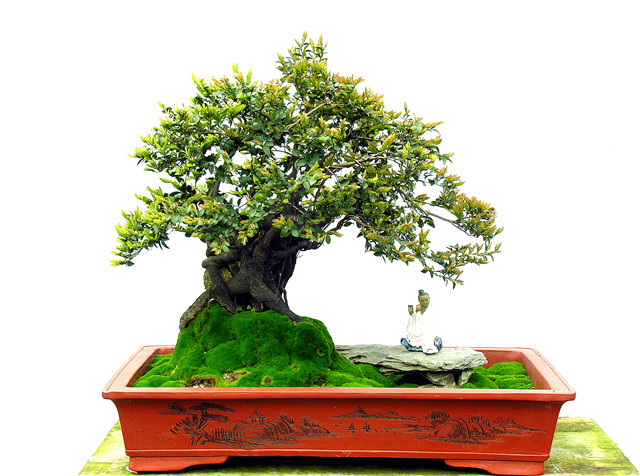Picture of how to grow flowers and leaves and periwinkle
Vinca major var. variegata) is a variety of periwinkle belonging to periwinkle genus of oleander family. Distribution in Jiangsu and other places in the mainland of China, has not yet been artificially introduced cultivation. Dwarf, vine branches, creeping growth, up to more than 2 meters. Leaves elliptic, opposite, petiolate, bright green, glossy, margin creamy yellow. Leaf margin white, with yellow-white spots. Cultivated in Jiangsu, Fujian, Guangxi, Guangdong, Hubei, Hunan and other provinces. Tendril subshrub. Dwarf, vine branches, creeping growth, up to more than 2 meters. Leaves elliptic or ovate, apex acute, opposite, petiolate, bright green, shiny, leaf margin milk yellow, tillering ability is very strong. High-footed butterfly-shaped corolla, flowers solitary, violet. After introduction and cultivation test, it was found that it has strong adaptability, loose soil requirements and fast growth. A variety of periwinkle belonging to the genus periwinkle in the family oleander. The plant likes light and bears shade, and bears low temperature. Under the temperature of-7℃, there is no freezing injury in open field. The flowers and vines are evergreen all the year round. The vines that tiller out and the violet flowers that open in March cover the earth like a green carpet with flowers. The scenery is very spectacular. It is an ideal flower and appreciation ground cover material. It has strong adaptability, lax requirements for soil and fast growth. Let's introduce the small series of the network together below.

How to grow vine leaves?
Potted, summer to pay attention to shade, winter indoor winter displacement. Growth period to keep the basin soil moist, do not dry, while paying attention to ventilation. It is advisable to apply thin fertilizer 2-3 times a year; if too much fertilizer is applied, the graceful characteristics of the plant will be lost. When planting, heavy pruning should be carried out to promote branching. After that, a proper pruning should be carried out every spring to shorten the main vine to control the growth too long. Pay attention to environmental ventilation at ordinary times.
soil
Ivy on the soil requirements are not strict, barren resistance, like wet, loose, fertile sandy soil, avoid salt alkaline soil. Generally, fertile loose soil is used as potting substrate, such as garden soil and rotten leaf soil mixed equally, or it can be prepared by rotten leaf soil, peat soil and fine sand soil plus a small amount of base fertilizer, or by pastoral soil, about 1/4 plant ash, a small amount of base fertilizer mixed, plant ash can not only keep pot soil loose and breathable, but also have more potassium fertilizer to meet ivy growth. It can also be grown alone with water.
illumination
Ivy is a typical shade vine flowers and trees, resistant to humidity, can also grow in full light environment. It can be cultivated in a bright room for a long time. In a dark room, as long as the light is supplemented, it can also grow well. It grows well in warm and humid climate conditions and is not cold resistant.
When a large number of branches and leaves germinate in spring, no matter whether they are flowers or leaves, they should be placed in the sun and receive sufficient light, so that the branches and leaves will grow luxuriantly and robustly. Usually should be placed in diffuse light, in order to make the leaf color dark green and shiny, mosaic varieties in the shading environment, leaf color more beautiful. Summer heat must be placed in a cool and ventilated place.
watering
Be careful of plum rains and high summer temperatures. Plum season placed outdoors ivy, basin a ponding should be poured out in time, so as not to root for a long time by stains, rot. Summer environmental temperature is high, adverse to ivy growth, growth stagnation above 30℃, so it is appropriate to use more foliar spray irrigation. Insufficient water, plant base easy to defoliate; watering too much easy to rot roots. You can choose to water in the morning or evening to avoid a large difference between the soil temperature and water temperature, causing the roots to be injured and eventually causing the plants to wither and die.
Winter into the greenhouse winter, indoor to maintain the humidity of the air, not too dry, but the basin soil should not be too wet.
When transplanting, pay attention to making its roots soil, easy to survive.
pest control
Enhanced ventilation and ventilation can reduce the occurrence of pests. Ivy often occurs aphids in spring, in high temperature and dry, poor ventilation conditions are also prone to red spiders, scale insects, mites harm, should be sprayed early control.
Summer sultry climate, easy to occur pests, mainly scale insects, especially leaf back and petiole for more, strengthen ventilation, can reduce the occurrence of pests. If pests are few, use an old toothbrush dipped in soapy water to brush. In case of many pests, 40% omethoate 800 times liquid can be sprayed once every 7 days, continuously spraying 2 to 3 times.
How to cultivate and cultivate the vine leaves, the vine leaves, the vine cuttings, propagation and management
Variegated periwinkle, also known as variegated ivy, is a variety of periwinkle belonging to Apocynaceae, distributed in Jiangsu and other places in the mainland of China, dwarf branches creeping growth, up to more than 2 meters long, leaves elliptic opposite, petioles, white edges of leaves, yellow and white spots, let's take a look at the cultivation method of flowering periwinkle!
The growth habits of flowering vine
V. variegata likes light, bears shade, and bears low temperature. Under the temperature condition of-7℃, there is no freezing injury phenomenon in open field cultivation. Evergreen all the year round, the vines tiller out and the violet flowers blooming in March cover the earth like a green carpet decorated with flowers. The scenery is very spectacular. It is an ideal ground cover material with flowers and leaves, strong adaptability, lax requirements for soil and fast growth.
The method of propagation of flowering vine
1. Plant division: Plant division and propagation should be carried out in spring. At this time, the old branches of the previous year should be cut off, the plants should be separated, planted separately, and watered thoroughly.
2, cuttage: cuttage propagation can be carried out throughout the year, cuttage matrix with good water retention performance of pearlite, vermiculite or sand, autumn and winter cuttage should be carried out in the greenhouse or sunny bed, winter in the greenhouse with electric hotbed cuttage rooting rate is higher.
The cultivation method of flowering vine
1. Soil: The flowering vine likes fertile and moist soil. It requires loose and humus-rich sandy loam for cultivation. When potted, it can be mixed with rotten leaf soil garden and river sand as substrate.
2. Topping: Each pot of flowering vines can be planted with multiple plants at the same time and timely topping, which can be rapidly formed. In order to promote multiple branches, multiple topping can be carried out during the growing season. Adventitious roots can be added to the soil at the nodes to promote the growth of vines.
3. Watering: The cultivation of flowering vines should be watered in dry days, drained in rainy season, fully watered during the growth period, kept the pot soil moist and moist, and applied liquid fertilizer 1~3 times a month to ensure that the vines grow fast and the leaves are green and bright.
4, light: mosaic vine Changchun suitable for bright light environment, but in midsummer to avoid direct light, so as not to burn the leaves, must be properly shaded, to the best semi-shade environment.
5, temperature: although the growth of flowering vines is warmer, but also cold-resistant, winter can withstand low temperatures around 0℃, in addition to cold throughout the year can maintain good color.
6, disease: mosaic vine disease often blight, canker disease and leaf spot disease occur, can be sprayed with the same amount of Bordeaux mixture control.
7. Insect pests: scale insects and root wart nematodes are harmful to mosaic vine pests. Scale insects are sprayed with 1000 times solution of 25% sulfomethion emulsifiable concentrate, and root wart nematodes are controlled with 3% furadan granules.
Is periwinkle poisonous? How to grow at home
Recently, I heard someone asking if there was poison in the flower leaf vine, which caused a lot of heated discussion. Because many people had never heard of what was the Evergreen Leaf, they didn't know whether it was poisonous or not. In fact, this variegated evergreen is a variety of periwinkle belonging to the genus Periwinkle of Apocynaceae, which is a very common foliage plant in life. Some people ask if it is poisonous, which is caused by people's lack of deep understanding of it. So let's take a look at the flowers and leaves together.
A brief introduction to Viburnum grandiflorum
Periwinkle, also known as periwinkle, is a variety of periwinkle belonging to the genus Periwinkle of Apocynaceae, which is mainly distributed in Jiangsu and other places in China. Viburnum is a kind of vine semi-shrub, creeping growth, good growth of Viburnum can grow to more than 2 meters in length. Evergreen leaves were elliptic and oval shape, its sharp tip, petiole, bright green, shiny, and leaf margins are milk yellow, tillering ability is very strong. Evergreen flowers, flowers similar to the high-legged butterfly corolla, flowers single course violet, looks very elegant and beautiful. Evergreen is a plant that can purify the air and green the environment. It is not poisonous.
Propagation method of vine mosaic evergreen
At present, there are two main methods for propagation of mosaic vine evergreen, i.e., ramets and cuttings. The propagation of split plants is mainly carried out in spring, and the old branches on the plants are cut off and the new plants are thrown out for different planting. Cuttage propagation flowers and vines evergreen can be carried out all the year round, is currently the most common method. When cutting, choose healthy and full flowering vines as cuttings, but pay attention to the length of cuttings should be determined according to the season, winter should be long, about 10-13cm; summer water evaporation is large, cuttings should not be too long, about 8-10cm. The upper part of the cuttings should be reserved for 2 leaves, while the lower part needs to be cut off. Finally, it can be planted in pearlite or sandy soil, and then watered. Pay attention to watering thoroughly.
Cultivation and Management of Viburnum grandiflorum
1. Evergreen vine likes fertile environment. When cultivating, it is necessary to prepare loose and humus-rich sandy soil, or mix rotten leaf soil with river sand as soil matrix, and apply liquid fertilizer 1 to 3 times a month.
2. Evergreen leaves like warm and sunny environment very much, so they should be exposed to the sun and keep their growth temperature. However, its cold tolerance is good, and it can still survive in winter when it is 0 degrees Celsius. At the same time, the sun is strong in summer, so attention should be paid to shading it to avoid leaves being burned.
3, the flowers and leaves are evergreen and wet. During the growth period, their growth speed is fast. They should be watered sufficiently to keep the pot soil moist. Single freezer cold, water demand is less, to reduce the number of watering, while the rainy season also to reduce water.
4. Diseases and insect pests occur during the cultivation period. Most of the diseases are blight, ulcer and leaf spot disease. The pests are mainly caused by scale insects and root wart nematodes. Attention should be paid to preventing diseases and insect pests during the cultivation period. Once found, it needs to be solved in time.
Conclusion: In a word, the vine is a very good purification of air and green environment foliage plants, it is not any toxin, and its flower type and color are more elegant and beautiful, so it has a certain ornamental value, can be used as a potted decoration, and the effect is good.
You may be interested.
? The whole picture of leaf paste painting? How to install a mosquito net? What benefit does drink chrysanthemum tea have? Oil painting? window flowers
? What is Lavender's Flower Language? Which brand of digital oil painting is good? What is polyester fabric? Dendrobium? summer sleeping mat
- Prev

Are geraniums poisonous? culture methods and matters needing attention of geraniums
Geranium (scientific name: Pelargoniumhortorum), alias hydrangea, stone red, red red, sunflower, belongs to the petunia family, including about 230 species of perennial fleshy, subshrub or shrub plants. Pelargonium is native to southern Africa and is widely cultivated all over the world
- Next

Black bone tea bonsai how to raise black bone tea picture
Black bone tea, also known as black sandalwood, black bone incense, produced in Xinhui, Taishan and other places, is a new bonsai tree species in the past 10 years. Due to strong ornamental, easy to take care of and other reasons, more and more people like it in recent years, coupled with slow growth without artificial cultivation, wild resources have almost been excavated, so the price has gone up all the way.
Related
- Fuxing push coffee new agricultural production and marketing class: lack of small-scale processing plants
- Jujube rice field leisure farm deep ploughing Yilan for five years to create a space for organic food and play
- Nongyu Farm-A trial of organic papaya for brave women with advanced technology
- Four points for attention in the prevention and control of diseases and insect pests of edible fungi
- How to add nutrient solution to Edible Fungi
- Is there any good way to control edible fungus mites?
- Open Inoculation Technology of Edible Fungi
- Is there any clever way to use fertilizer for edible fungus in winter?
- What agents are used to kill the pathogens of edible fungi in the mushroom shed?
- Rapid drying of Edible Fungi

